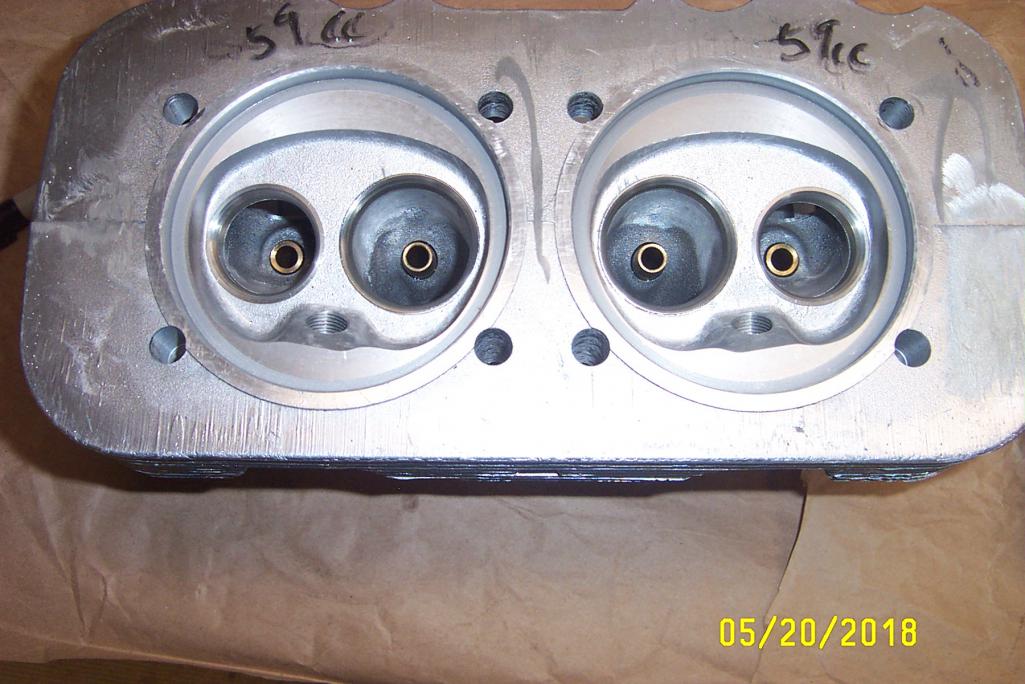Printable Version of Topic
Click here to view this topic in its original format
914World.com _ 914World Garage _ Where/What is reference plane- when flycutting heads?
Posted by: jjs3rd914 May 20 2018, 01:01 PM
Curiosity question.
When type 4 heads are to be fly-cut for increased compression, where/what plane does the machinist set up on. Videos seem to show the setup is the head being clamped on the valve cover surface to the mill table.....
So is that surface suppose to be parallel to the chamber sealing surface??
If so what is acceptable variance across the sealing circle to the valve cover surface.
We have measured our new set of 2L head castings and there is up to a .002" variance from on side of the sealing surface to the other with respect to the valve cover surface. So in this case the sealing surface is not parallel (in the same plane) to the valve cover surface? But does is matter as long as the sealing surface itself is flat all the way around to the to the cylinder top and both chambers on each head are in the same plane?
Do these heads need touched up?
What am I missing here??
Thanks
jjs3rd914
Posted by: Mark Henry May 20 2018, 02:16 PM
Yes, OK, maybe, nothing. ![]()
.002 is a hair, flycutting will correct it. Flycut only enough for clean up, don't increase CR this way, you will run into issues with the cylinder top fin.
No head gasket, use base shims to adjust CR, do the math. Minimum piston deck is .040" .
Best guess.... your guy is a type 1 guy...right?
T4 engine is similar but not the same.
Posted by: Mark Henry May 20 2018, 02:21 PM
Also to do it right machine the case decks flat.
The case deck is where the cylinder bottoms sit in the case.
Posted by: worn May 20 2018, 02:44 PM
Also to do it right machine the case decks flat.
The case deck is where the cylinder bottoms sit in the case.
Although I can see why one would use the valve cover side as a clamping surface, and thus it should be parallel, I don’t see why it matters if it isn’t as long as the surfaces sealing against the jugs are flat and on the same plane. What is the issue?
Posted by: Mark Henry May 20 2018, 02:52 PM
Also to do it right machine the case decks flat.
The case deck is where the cylinder bottoms sit in the case.
Although I can see why one would use the valve cover side as a clamping surface, and thus it should be parallel, I don’t see why it matters if it isn’t as long as the surfaces sealing against the jugs are flat and on the same plane. What is the issue?
40+ year old case decks start to collapse between the two cylinders, so it may not be flat.
Posted by: jjs3rd914 May 20 2018, 03:48 PM
Interesting discussion. I am learning.
I agree with Worn
" if it isn’t as long as the surfaces sealing against the jugs are flat and on the same plane. What is the issue?"
The question is to what does one reference to (measure from) to verify that the two adjacent sealing surfaces are indeed in the same plane.?
The only other surface besides the valve cover plane could be the machined surface sitting above the counter bore in the head. What is the purpose of this machined surface? See pic.
Anyhow here is some data. Using the valve cover plane surface as reference. Sealing surface on chamber #1 on the right in pic is the same relative measurement at 6 and 12 o'clock. But at 9 o'clock it is is .0015" higher to that of 6 and 12 o'clock, and at 3 o'clock .001" lower.
Chamber #2, at 6 is .0015 higher (referencing back to dimension on # 1 at 6 and 12), at 9 o'clock is .0005 lower, at 12 .0005 lower, and at 3 .001 higher.
So clearly the two planes are not parallel and are not at the exactly same height at least "relative to the valve cover surface"
Maybe this is acceptable. I do not know. As I said I am trying to understand and learn.
Yes Mark Henry my case registers are "collapsed" and case will be machined to even them out. I had all the new cylinders all machined to exactly the same height.
So we should be starting with straight parallel registers, then even cylinders, and hopefully even heads.
Thanks all
jjs3rd914
Posted by: wndsrfr May 21 2018, 05:30 AM
Hmmmm....maybe clean up the one with the least variance, then use it as the reference to get the second one perfect to it?
Posted by: Mark Henry May 21 2018, 09:05 AM
You can obsess over .0001" but it quickly becomes a game of a dog chasing its tail.
Powered by Invision Power Board (http://www.invisionboard.com)
© Invision Power Services (http://www.invisionpower.com)
